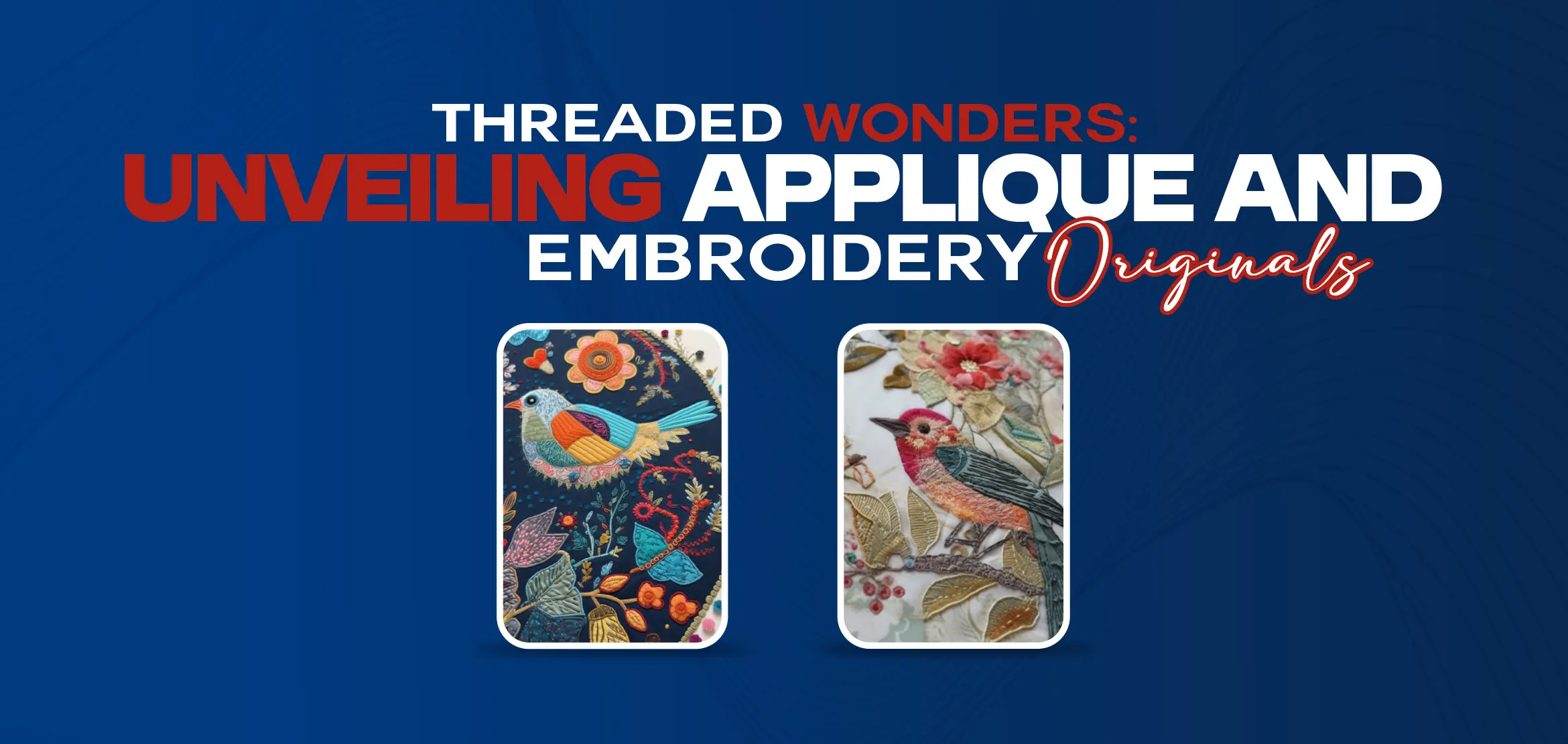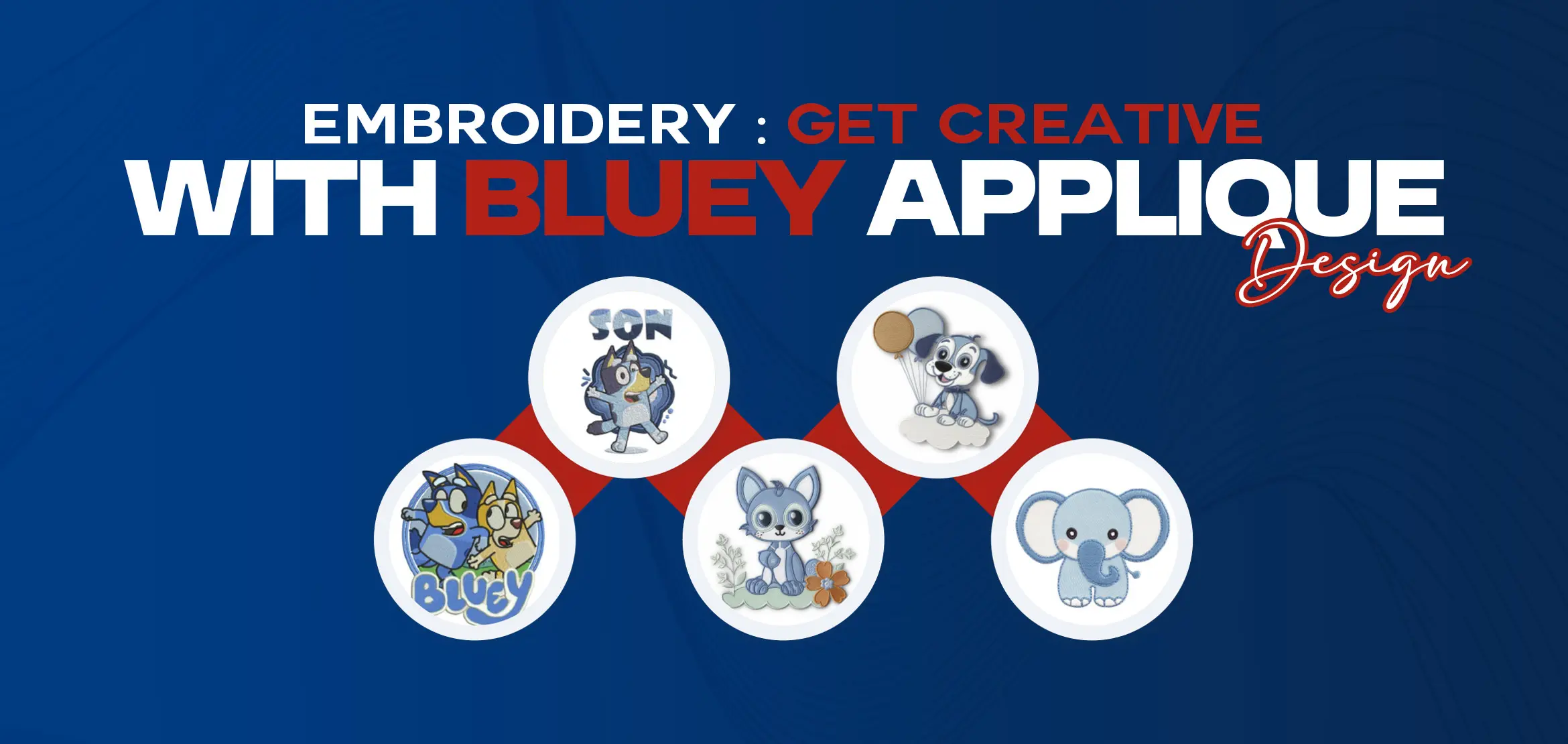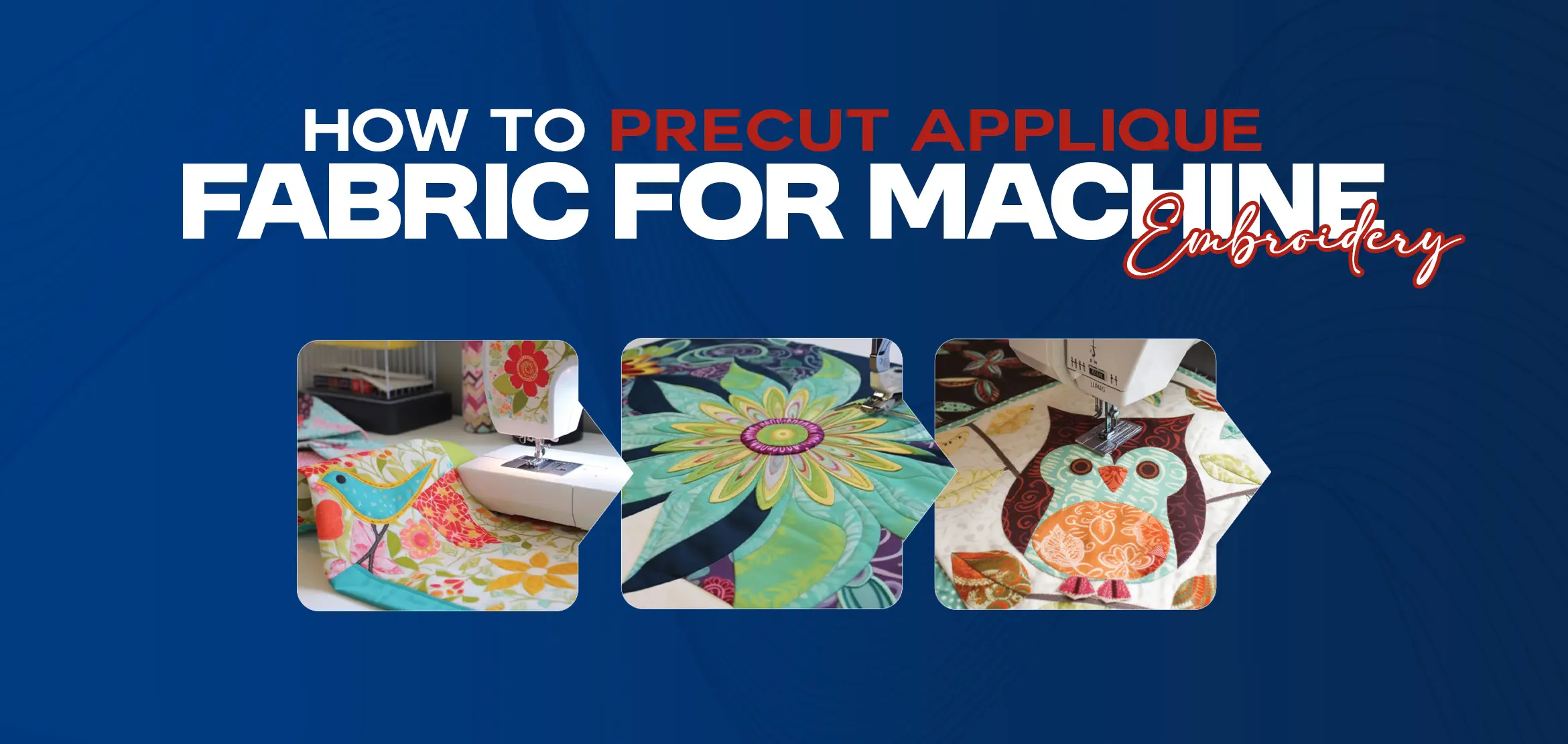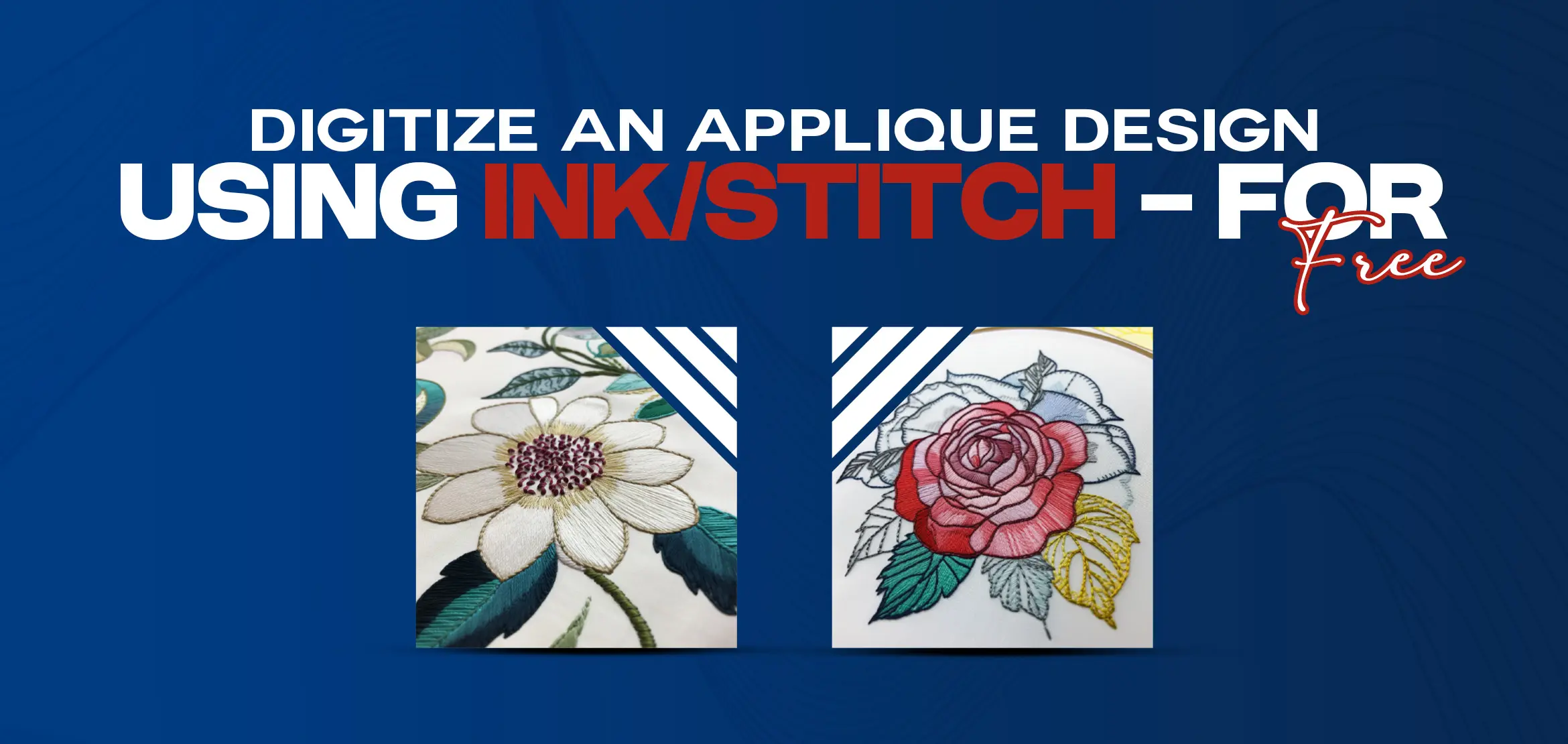
Threaded Wonders: Unveiling Appliqué and Embroidery Originals
Table Of Content
- 1. Introduction
- 2. Origins of Appliqué and Embroidery
- 3. Diverse Appliqué Techniques
- 3.1 Layered Appliqué
- 3.2 Reverse Appliqué
- 3.3 Fused Appliqué
- 4. The Art of Embroidery
- 5. A Journey Through History
- 6. Types of Embroidery Stitches
- 7. Symbiotic Creations: Appliqué Meets Embroidery
- 8. Contemporary Resurgence
- 9. Tools and Materials
- 10. Step-by-Step Appliqué Guide
- Step1: Selecting the Design
- Step2: Preparing the Base Fabric
- Step3: Choosing Fabrics for Appliqué
- Step4: Cutting and Layering
- 11. Commonly Used Embroidery Stitches
- 1. Backstitch
- 2. Chain Stitch
- 3. Lazy Daisy Stitch
- 12. The Artisan's Touch: Hand vs. Machine
- 12.1 Handwork
- 12.2 Machine Work
- 13. Wonders Brought to Life: Applications of Appliqué and Embroidery
- 14. Preserving Your Creations: Care and Maintenance
- 15. Unlocking Your Creativity: DIY Projects
- 16. Intricacy and Patience: The Zen of Threaded Art
- The Takeaway
- FAQs (Frequently Asked Questions)
Embroidery and appliqué are two ancient yet ever-evolving art forms that have graced fabrics with intricate designs for centuries. These threaded wonders bring life to garments, accessories, and decor through meticulous stitching and layering techniques. This article will explore the captivating world of appliqué and embroidery, their origins, methods, contemporary relevance, and the artistic brilliance they bring to diverse creations. In artistic craftsmanship, embroidery and appliqué reign as timeless techniques, infusing fabrics with a tapestry of culture, narratives, and captivating visual allure. Guided by the gentle dance of needles and the art of layering, these methods empower artisans to elevate humble fabrics into remarkable works of art, where the ordinary metamorphoses into the extraordinary. Delicately woven threads and intricate placements merge to craft masterpieces honoring tradition while embracing innovation. The origins of appliqué and embroidery can be traced to ancient civilizations, where their artistic roots run deep. Appliqué, the craft of skillfully stitching one fabric atop another to form intricate patterns, left an indelible mark on cultures worldwide. Simultaneously, embroidery graced garments, religious artifacts, and textiles with various stitches symbolizing prestige and aesthetic appreciation. These time-honored techniques were more than mere skills. They were cultural cornerstones that bridged creativity with tradition, leaving an enduring legacy across the globe. In the realm of appliqué, a treasure trove of techniques awaits exploration, each offering a distinct approach to fabric transformation. This technique is an artful dance of fabrics, where layers intertwine to produce remarkable depth. Artisans meticulously arrange and stitch fabrics together, creating intricate tapestries that captivate the eye. The interplay of textures and colors adds a three-dimensional quality, turning simple materials into complex visual narratives. A masterstroke of contrast, reverse appliqué involves strategically removing top fabric layers to unveil a hidden canvas beneath. The result is a striking juxtaposition of materials, where negative space becomes a compelling positive presence. This method thrives on the tension between seen and unseen, giving rise to designs that embody subtlety and surprise. Here, innovation meets precision. Fused appliqué employs adhesive materials to affix fabric pieces seamlessly. This technique enables artisans to control placement meticulously, achieving detailed designs that might be challenging with traditional stitching. The result is a marriage of accuracy and artistry, with each piece snugly adhered for a clean, polished finish. These diverse appliqué techniques demonstrate the art's versatility, offering artisans a rich palette to weave their creative visions. From layered opulence to the drama of reverse reveals and the precision of fused intricacies. Each method holds the power to transform fabrics into art, honoring traditions while fostering innovation. As crafters navigate these techniques, they're invited to explore, experiment, and reimagine the possibilities. Where threads and fabrics merge to create stories woven into tangible beauty. At the heart of the artistic realm lies the intricate craft of embroidery. With a history spanning eras, this skilful practice adorns fabrics with a symphony of stitches, each a brushstroke of creativity. From medieval regality to contemporary finesse, embroidery bridges time and style. Varied stitches, like the versatile running stitch, the elegance of the satin stitch, and the texture of French knots, compose narratives in thread. An ancient art form alive in the present, embroidery weaves stories, textures, and colors into textiles, turning cloth into canvases where imagination takes shape with every needle-driven stitch. Embroidery embarks on a timeless voyage, gracing medieval royal garments and seamlessly transitioning into today's fashion landscape. This journey bridges antiquity and modernity, where threads weave tales of tradition and innovation. From the luxury of regal robes to the present-day fusion with contemporary styles, embroidery's evolution transcends eras, celebrating the past while adorning the present with its enduring allure. Embroidery stitches are the paintbrushes of the textile world, each stroke crafting a unique effect. Running Stitch: A fundamental stitch known for its simplicity and adaptability. Consisting of evenly spaced tiny stitches, it creates lines, outlines, and textures, serving as the cornerstone of embroidery. Satin Stitch: This stitch is a master of smoothness, perfect for filling shapes with its closely packed stitches. The result is a polished, almost seamless surface, ideal for petals, leaves, and intricate detailing. French Knots: Tiny but impactful, French knots add a touch of whimsy and dimension. Crafted by wrapping the thread around the needle, they can mimic everything from flower centers to delicate freckles, infusing character into the design. In the hands of artisans, these stitches transform fabric into a canvas of texture, depth, and visual storytelling, showcasing the endless possibilities of embroidery. The fusion of appliqué and embroidery births captivating artistry. Here, the synergy between techniques ignites enchantment. Embroidery, with its intricate details, elevates appliqué, adorning it with nuanced accents. Conversely, appliqué enriches some free embroidery designs with profound dimensions. A harmonious partnership, these techniques converse in threads, crafting enchanting tales on fabric canvases. It's a dance where layers come alive with texture, and stitches breathe life into shapes. This union transcends the sum of its parts, offering a realm where creativity knows no bounds and where the tactile beauty of appliqué converges with the ethereal elegance of embroidery. Amid the rapid pace of the modern world, the allure of these art forms remains steadfast, experiencing a vibrant revival. Today, their relevance is not only intact but thriving. Visionary designers seamlessly infuse appliqué and embroidery into haute couture, streetwear, and home aesthetics. These age-old techniques, nurtured by tradition, seamlessly interlace with contemporary sensibilities. As the threads of time weave forward, the enduring beauty of appliqué and embroidery continues to captivate, adapting to new contexts and captivating a generation that appreciates the seamless blend of history and innovation. Embarking on an appliqué and embroidery voyage requires assembling a toolkit: fabrics, needles, threads, embroidery hoops, and fabric glue. The essence lies in high-quality resources that safeguard the durability of your artistic pursuits. These tools are the conduits through which creativity flows, and as you gather them, you forge a connection to centuries-old traditions while crafting contemporary marvels. With every stitch, the harmony of well-chosen tools and fine materials elevates your journey, transforming mere fabrics into vessels of imagination and craftsmanship. Embarking on an appliqué journey requires a thoughtful sequence of stages, each contributing to the transformation of fabric into an artistic marvel. Choosing an advanced embroidery design that aligns with your creative essence is central to the process. Whether elegantly simple or intricately complex, your preferred format should resonate deeply with you. It reflects your passion and artistic vision, serving as the foundation upon which your masterpiece will emerge. Consider the base fabric as your canvas, awaiting the brushstrokes of appliqué. Before starting, ensure its surface is pristine. Cleanliness and smoothness are essential, providing the optimal backdrop for your artistry to unfold. Iron out any creases, ensuring the fabric is ready to embrace the transformation that awaits. In this step, fabric selection becomes an art in itself. Opt for fabrics that either contrast or complement the base fabric. The interplay of colors, textures, and patterns introduces depth and visual intrigue to your design. This choice can dictate the mood and impact of your creation, elevating it beyond mere fabric and thread. Precision takes the forefront as you cut out the appliqué shapes. These shapes are the components that will breathe life into your design. Layer them purposefully, experimenting with placement to achieve a dimensional effect that adds depth and complexity. Your plan takes form at this juncture, each layer contributing to the narrative. Step5: Stitching the Appliqué Your efforts culminate as you stitch the appliqué shapes onto the base fabric. Employing embroidery stitches, you marry the layers seamlessly, unifying the elements into a cohesive whole. This step is akin to the final brushstrokes on a painting, infusing the design with texture, detail, and unity. As you progress through these steps, remember that appliqué is not merely a process but an unfolding story. Each stage is a chapter, interwoven with your creativity and precision, leading to a culmination greater than the sum of its parts. The fabric becomes a canvas for expression through your hands, and the thread transforms into a narrative medium. Embroidery stitches are akin to a language spoken by a thread. They paint lines, textures, and motifs on the fabric canvas. Here are three commonly used stitches that form the vocabulary of embroidery: A steadfast companion, the backstitch creates a strong and versatile outline. It's perfect for contours, text, and fine detailing. This technique ensures durability and clarity by doubling back on the previous stitch. This stitch weaves a textured line, resembling a chain as it forms. It's flexible, offering options for thickness and spacing. The chain stitch is often used for borders and curves, which lends a graceful flow to your design. Playful and charming, the lazy daisy stitch crafts petal-like accents. It's perfect for creating floral motifs or individual decorative elements. A single stitch forms the foundation, while loops generate the appearance of delicate petals. As you venture into embroidery, remember that each stitch is a brushstroke, and every choice—the fabric, the hoop, the stitches—is a creative decision that shapes the final artwork. From the fabric's embrace to the rhythmic dance of the needle, embroidery is a symphony where threads whisper stories, and stitches sing the song of artistry. In the world of embroidery and appliqué, two paths beckon: the artisan's hand and the machine's precision. Each possesses its allure, crafting a unique narrative. resonates with authenticity, weaving a connection between the creator and the creation. Every stitch bears the imprint of human touch, imbuing the work with emotions and imperfections that tell a personal story. It's a patient journey where time and devotion are stitched into every fibre. On the other hand, offer a different kind of magic. They wield precision and speed, executing intricate designs with mechanical finesse. This approach is a symphony of technology and artistry, resulting in uniformity that's a testament to human ingenuity. From haute couture catwalks to cherished personalized gifts, the realms of appliqué and embroidery extend across a diverse spectrum. On high-fashion runways, these techniques elevate garments to art, showcasing the synergy of tradition and innovation. In gifting, they breathe life into personalized items, infusing them with sentiment and aesthetic finesse. Home decor, accessories, and even corporate branding bear the mark of these threaded wonders, turning everyday objects into remarkable statements. Ensuring the longevity of your embroidered and appliquéd creations is an art in itself. Proper care and storage are paramount. Shield them from harsh sunlight, humidity, and excessive handling. Regularly dust and clean, using gentle methods to safeguard the stitches and fabrics. Treating your creations with care, you extend their lifespan, preserving the vibrancy and beauty you've poured into each piece. Venture into DIY projects, where your skills intertwine with imagination. These projects offer a canvas to experiment, innovate, and refine your craft. Through bespoke pieces, you'll not only master techniques but also infuse each creation with your unique artistic vision. These projects bridge learning and innovation, propelling you from novice to artist. Appliqué and embroidery are more than techniques. They're meditative practices. The intricate work demands patience and unwavering attention to detail. As you thread the needle and navigate the stitches, you enter a tranquil zone where time slows and creativity thrives. This Zen-like experience transcends the final product. It's about finding solace in each stitch, discovering beauty in the process, and creating a masterpiece that's visual and a testament to your inner peace. Appliqué and embroidery stand as testaments to human creativity and craftsmanship. Their interplay weaves stories, cultures, and emotions into fabric, creating timeless pieces that bridge past and present. As you explore the world of threaded wonders, remember that every stitch is a journey, and every creation is a masterpiece. If you're interested in having your embroidery stitched using our embroidery services, don't hesitate to get in touch with DigitizingUSA. Q1. Can I mix different appliqué techniques in one project? Absolutely! Mixing techniques can yield unique and stunning results. Q2. Is embroidery only for fabric, or can it be used on other materials? While fabric is most common, embroidery can be applied to leather, paper, and wood. Q3. Is hand embroidery more time-consuming than machine embroidery? Hand embroidery takes more time, but the personal touch is invaluable. Q4. Can I wash garments with appliqué and embroidery? Yes, but use gentle cycles and avoid harsh detergents to preserve the artwork. Q5. Where can I find inspiration for my appliqué and embroidery projects? Nature, art, and cultural motifs are excellent sources. Also, explore online communities for ideas.1. Introduction
2. Origins of Appliqué and Embroidery
3. Diverse Appliqué Techniques
3.1 Layered Appliqué
3.2 Reverse Appliqué
3.3 Fused Appliqué
4. The Art of Embroidery
5. A Journey Through History
6. Types of Embroidery Stitches
7. Symbiotic Creations: Appliqué Meets Embroidery
8. Contemporary Resurgence
9. Tools and Materials
10. Step-by-Step Appliqué Guide
Step1: Selecting the Design
Step2: Preparing the Base Fabric
Step3: Choosing Fabrics for Appliqué
Step4: Cutting and Layering
11. Commonly Used Embroidery Stitches
1. Backstitch
2. Chain Stitch
3. Lazy Daisy Stitch
12. The Artisan's Touch: Hand vs. Machine
12.1 Handwork
12.2 Machine Work
13. Wonders Brought to Life: Applications of Appliqué and Embroidery
14. Preserving Your Creations: Care and Maintenance
15. Unlocking Your Creativity: DIY Projects
16. Intricacy and Patience: The Zen of Threaded Art
The Takeaway
FAQs (Frequently Asked Questions)






